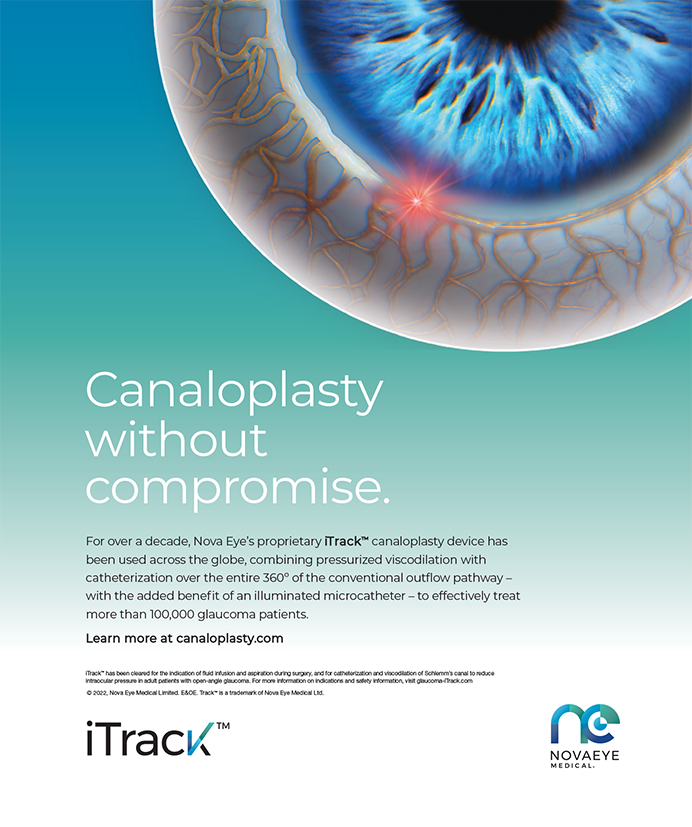CASE PRESENTATION
A 56-year-old white female complaining of decreased vision presented with a +2 to +3 nuclear sclerotic cataract in her left eye. I planned to perform cataract surgery utilizing the AdvanTec NeoSoniX technology on the Series 20000 Legacy Phacoemulsification system (Alcon Laboratories, Inc., Fort Worth, TX), and to implant an IOL. I found no pre-existing ocular conditions that warranted concern.
I began the procedure by administering topical anesthesia to the cornea and then making a clear corneal wound superiorly, followed by a circular capsulorhexis. During hydrodissection of the nucleus, I discerned a distinct posterior fluid wave, indicating that the epinucleus had separated from the cortex. Following a successful four-quadrant fracture, I removed the final nuclear fragments using the Kelman phaco handpiece (Alcon Laboratories, Inc.) and with the help of the NeoSoniX technology. Next, I used the phaco handpiece to remove the epinucleus, and I accomplished this without incident. I began I/A with a flexible silicone handpiece (Alcon Laboratories, Inc.) and intermittently aspirated the posterior capsule. At this point, pressure began to build in the eye, the chamber grew shallower, and it became impossible to remove the cortex. I surmised that the increased bulk of the flexible silicone sleeve might have damaged some zonules upon entry into the anterior chamber. As a result, an aqueous misdirection syndrome had developed within the eye which caused fluid traveling from the I/A tip to be diverted into the vitreous cavity via an area of weakened zonules.
HOW WOULD YOU PROCEED?1. Would you simply proceed with the surgery?
2. Postpone the procedure until the IOP normalized?
3. Surgically decompress the globe while the patient is on the table?
SURGICAL COURSE
In an instance such as this, the surgeon must quickly concern himself with differentially diagnosing the cause of the elevated posterior pressure during phacoemulsification. Often, it is due to a choroidal effusion or hemorrhage. Sometimes, an effusion or hemorrhage can be identified at the surgical microscope by a diminished red reflex in the periphery. It is best, however, to rule out this occurrence by performing indirect ophthalmoscopy before resuming surgery. Eliminating the possibility of a choroidal hemorrhage or effusion will allow you to complete the procedure by decompressing the vitreous cavity.
I performed indirect ophthalmoscopy, which revealed a flat retina. The patient's red reflex was clear, and there was no sign of cortical fusion. I decided to perform a vitreous aspiration.
First, I made a conjunctival incision 2 mm posterior to the limbus and inserted a 23-gauge needle (attached to a 3-cc syringe) into the anterior vitreous cavity in an attempt to isolate a pocket of fluid, aspirate it, and decompress the globe (Figure 1). I could easily see vitreous flowing into the needle, but it was not being aspirated by this technique. Again, I confirmed an absence of choroidal effusion or hemorrhage. Despite the eye's elevated IOP, its red reflex remained satisfactory. Subsequently, I decided to proceed with a pars plana vitrectomy. I positioned the vitrector in the posterior segment and directed its opening away from the capsule to avoid creating an opening in the posterior capsule (Figure 2). I continued the vitrectomy until the eye decompressed and the capsule floated anteriorly. After testing the IOP, which now felt normal, I reinserted a metal I/A handpiece into the anterior chamber to remove the subincisional cortex located in the 12-o'clock position. After successfully removing the cortex, I injected Provisc (Alcon Laboratories, Inc.) into the capsular bag and then inserted an SA60AT acrylic lens (Alcon Laboratories, Inc.). I allowed the implant to unfold and dialed the haptics into the capsular bag without difficulty.
As I dialed in the implant, the IOP rose again. With the IOL in place, I reinserted the vitrectomy instrument through the pars plana incision and into the vitreous chamber. I removed additional vitreous to decompress the eye again, and then reinserted the I/A tip into the anterior chamber to remove as much viscoelastic as possible.
OUTCOME
Following the completion of the case, the patient had an uneventful postoperative course. Her UCVA was 20/25 on the first postoperative day. One year has passed since her surgery, and the patient has had no postoperative complications.


